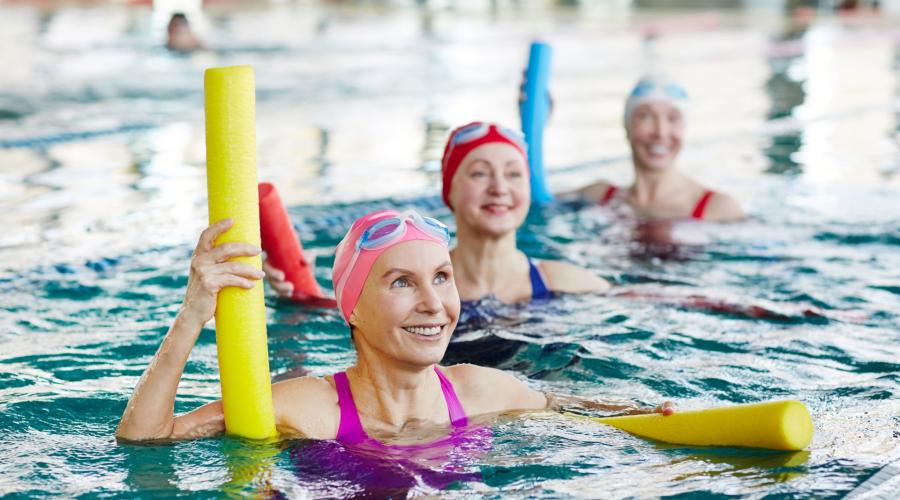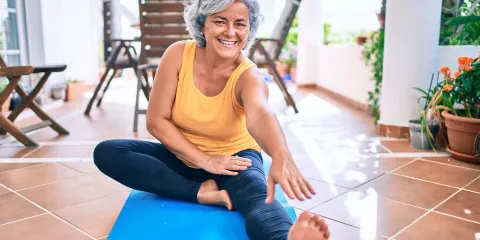
We know that staying active is an important part of a healthy lifestyle, but when working out is a chore, it becomes harder and harder to stick with an exercise routine. Finding new ways to get your body moving is a great way to get more active, try something new, and continue experiencing the multiple benefits of working out. If you’re looking for a fun, unique, and low-impact exercise, why not try water aerobics?
Related: Unconventional Exercises that Don’t Feel Like A Workout
What Is Water Aerobics?
Water aerobics is a type of aerobic exercise (meaning it gets your heart rate up) that’s completed in a swimming pool. Water aerobics is performed in waist-deep water or deeper and rarely includes swimming. Many of the exercises in a water aerobics class are similar to a normal aerobics class, but because water is so buoyant, moves can be completed with less impact on the joints.1
Benefits of Water Aerobics
In general, water aerobics is a great exercise option for people of all ages, but can be especially useful for seniors or those with joint concerns. Some of the biggest benefits of trying water aerobics include:
It’s Low-Impact
The added buoyancy of water helps support your body, lessening the stress on your joints. This may give you a greater range of motion and allow you to perform exercises that wouldn’t be comfortable on land.2 For this reason, when conducted appropriately and in deep enough water, water-based exercise also presents a lower risk of injury from traumatic fractures.3
Read More: Low-Impact vs High Impact Exercise
It Could Reduce Pain And Improve Overall Fitness
Studies have demonstrated that water-based exercises can play a role in reducing pain for individuals with arthritis or other conditions.4 At the same time, water-based exercises can improve flexibility, strength, and balance.5 These benefits may help improve your overall quality of life and help reduce injuries in the future.678
It Supports Heart Health
In addition to being low-impact and improving overall fitness, aquatic exercises support cardiovascular health. Water aerobics can provide many of the same health benefits as land-based cardiovascular exercise, like a reduction in blood pressure, a reduction in LDL and total cholesterol, and an increase in HDL cholesterol (known as “good cholesterol”), particularly when practiced consistently and combined with other lifestyle modifications.9
How To Get Started With Water Aerobics
Before starting with water aerobics (or any new exercise), consult your doctor to discuss how you can safely add more movement into your day. If your doctor agrees that water aerobics may be right for you, look for classes near you so you can learn the basic moves and ensure you’re using good form to avoid injury. When starting water aerobics, keep in mind:
- You should have a buddy: Make sure someone else is in the pool with you during your workout. This can be your instructor, lifeguard, a friend, or a family member.
- Start in the shallow end: If you’re not a confident swimmer or have never tried water-based exercise before, start in the shallow end and slowly work your way to deeper parts of the pool. Most aerobic exercises can be completed in waist-shoulder depth.
- Familiarize yourself with your environment: Before starting your workout, familiarize yourself with the facility. Make sure you know where the shallow end drops off, where ladders and stairs are, and where lifeguards are located in the case of an emergency.
- Start slow: Like any workout program, start slowly and listen to your body. Even simple movements, like walking in the water, can create a strong foundation for increased movement.
Ready to try water aerobics? Ask about classes at your local rec center. If you want a class geared towards your age range and abilities, check out water-based exercise classes through Silver Sneakers, the Arthritis Foundation, or related organizations.
References
1 https://www.healthline.com/health/arthritis-water-exercises#choose-water-exercise
2 https://www.webmd.com/osteoarthritis/features/watery_workout
3 https://www.ncbi.nlm.nih.gov/pmc/articles/PMC5376183/
4 Svedenhag J: Running on land and in water: comparative exercise physiology. Med Sci Sports Exerc, 1992, 24: 1155–1160
5 The effect of water exercise therapy given to patients with rheumatoid arthritis. Danneskiold-Samsøe B, Lyngberg K, Risum T, Telling M Scand J Rehabil Med. 1987; 19(1):31-5.
6 Falls in the elderly: reliability of a classification system. Lach HW, Reed AT, Arfken CL, Miller JP, Paige GD, Birge SJ, Peck WA J Am Geriatr Soc. 1991 Feb; 39(2):197-202.
7 Risk factors for falls among elderly persons living in the community. Tinetti ME, Speechley M, Ginter SF N Engl J Med. 1988 Dec 29; 319(26):1701-7.
8 Aging and posture control: changes in sensory organization and muscular coordination. Woollacott MH, Shumway-Cook A, Nashner LM Int J Aging Hum Dev. 1986; 23(2):97-114.
9 https://www.ahajournals.org/doi/full/10.1161/01.CIR.0000048890.59383.8D












